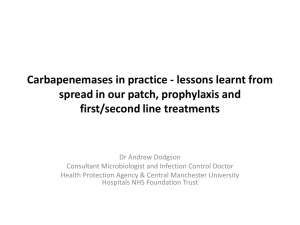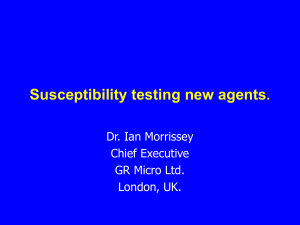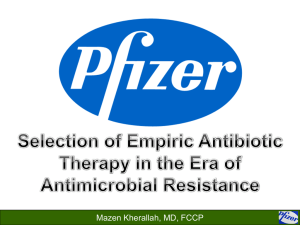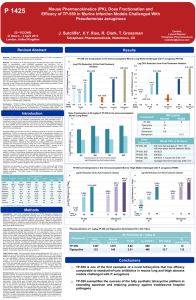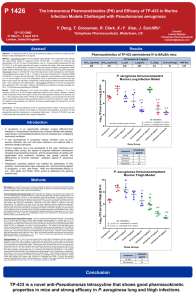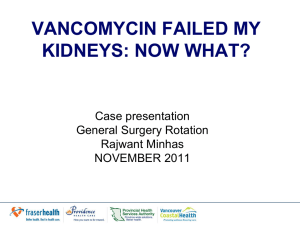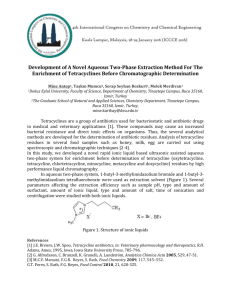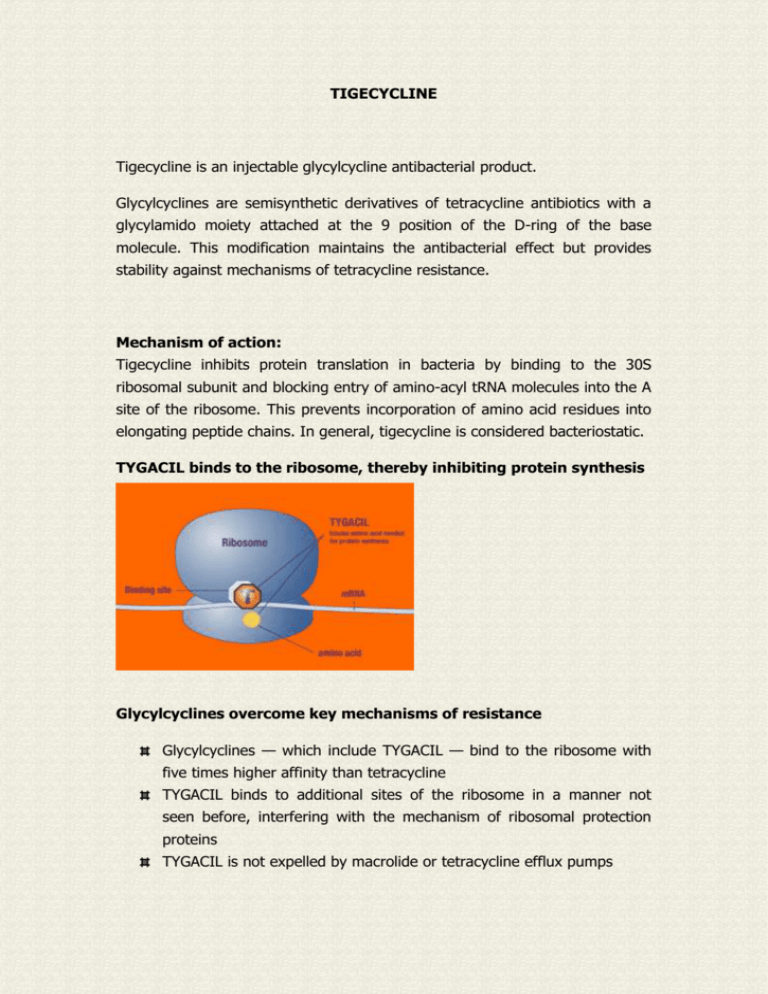
TIGECYCLINE
Tigecycline is an injectable glycylcycline antibacterial product.
Glycylcyclines are semisynthetic derivatives of tetracycline antibiotics with a
glycylamido moiety attached at the 9 position of the D-ring of the base
molecule. This modification maintains the antibacterial effect but provides
stability against mechanisms of tetracycline resistance.
Mechanism of action:
Tigecycline inhibits protein translation in bacteria by binding to the 30S
ribosomal subunit and blocking entry of amino-acyl tRNA molecules into the A
site of the ribosome. This prevents incorporation of amino acid residues into
elongating peptide chains. In general, tigecycline is considered bacteriostatic.
TYGACIL binds to the ribosome, thereby inhibiting protein synthesis
Glycylcyclines overcome key mechanisms of resistance
Glycylcyclines — which include TYGACIL — bind to the ribosome with
five times higher affinity than tetracycline
TYGACIL binds to additional sites of the ribosome in a manner not
seen before, interfering with the mechanism of ribosomal protection
proteins
TYGACIL is not expelled by macrolide or tetracycline efflux pumps
TYGACIL provides an expanded broad spectrum of in vitro activity
Gram-positive pathogens, including methicillin-resistant Staphylococcus
aureus
epidermidis (MRSE), and
vancomycin-resistant enterococci (VRE)—Enterococcus faecalis and
Enterococcus faecium1
Gram-negative pathogens, including Acinetobacter baumannii and
Stenotrophomonas maltophilia
(MRSA)
and
Staphylococcus
Anaerobic pathogens
Tigecycline is generally considered bacteriostatic.
Pharmacokinetic studies of tigecycline have been conducted in healthy
subjects and in special patient populations such as those with hepatic or renal
impairment and the elderly. In studies involving healthy subjects given
intravenous (IV) tigecycline (100 mg followed by 50 mg every 12 hours), the
steady-state Cmax was 0.87 ± 0.23 μg/mL for 30-minute infusions and 0.63 ±
0.097 μg/mL for 60-minute infusions; the steady-state AUC0-12h was 2.35 ±
0.85 μg•h/mL. The graph below presents the serum concentration-time
profile in a typical subject.
Serum Concentration-Time Profile
Protein Binding
The in vitro plasma protein binding of tigecycline ranges from approximately
71% to 89% at concentrations observed in clinical studies (0.1 to 1.0 μg/mL).
The moderate degree of protein binding observed in vitro is unlikely to result
in drug-drug interactions that would significantly impact the safety or efficacy
of tigecycline.
Distribution
The steady-state volume of distribution of tigecycline averaged 500 to 700 L
(7 to 9 L/kg), indicating that tigecycline is extensively distributed beyond the
plasma volume and into the tissues.
Metabolism
Tigecycline is not extensively metabolized. In vitro studies with tigecycline
using human liver microsomes, liver slices, and hepatocytes led to the
formation of only trace amounts of metabolites. In healthy male volunteers
receiving
14C-tigecycline,
tigecycline was the primary
14C-labeled
material
recovered in urine and feces, but a glucuronide, an N-acetyl metabolite, and a
tigecycline epimer (each at no more than 10% of the administered dose)
were also present.
Elimination
Following IV administration, tigecycline serum concentrations initially decline
rapidly during distribution into body tissues. The mean half-life of tigecycline
after a single 100-mg dose was 27.1 hours; after multiple dosing of 50 mg
every 12 hours, the mean half-life was 42.4 hours. Approximately 59% of a
radioactive dose is eliminated by biliary/fecal excretion, and 33% is excreted
in urine. Of the total dose, approximately 22% is excreted as unchanged
tigecycline in urine. The majority of the urine recovery (22%) occurred on the
first day. Conversely, very little fecal recovery occurred on day 1 (0.03%),
with the majority recovered thereafter. The primary route of elimination of
tigecycline is biliary excretion of unchanged tigecycline and its metabolites.
Secondary
routes
are
renal
excretion
of
unchanged
tigecycline,
glucuronidation, and amide hydrolysis followed by N-acetylation to form Nacetyl-9-aminominocycline.
Postantibiotic Effect
The in vitro postantibiotic effect of tigecycline was 3.4 to 4 hours for strains of
S. aureus and 1.8 to 2.9 hours for strains of E. coli, including those carrying
selected resistance determinants. In a localized neutropenic mouse thigh
infection model, tigecycline exhibited a long in vivo postantibiotic effect: 8.9
hours for S. pneumoniae and 4.9 hours for E. coli. Both area under the curve
(AUC) and time above a fraction of minimum inhibitory concentration (MIC)
correlated with efficacy. Because tigecycline exhibited time-dependent
bacterial killing properties in combination with a moderate-to-prolonged
postantibiotic
effect,
the
AUC/MIC
ratio
is
likely
the
primary
pharmacokinetic/pharmacodynamic determinant of efficacy.
Indications and Usage
TYGACIL is indicated for the treatment of adults with:
complicated skin and skin structure infections caused by
Escherichia coli, Enterococcus faecalis (vancomycin-susceptible isolates
only), Staphylococcus aureus (methicillin-susceptible and -resistant
isolates), Streptococcus agalactiae, Streptococcus anginosus group
(includes
S.
anginosus,
S.
intermedius,
and
S. constellatus), Streptococcus pyogenes, and Bacteroides fragilis
complicated intra-abdominal infections caused by Citrobacter freundii,
Enterobacter cloacae, Escherichia coli, Klebsiella oxytoca, Klebsiella
pneumoniae, Enterococcus faecalis (vancomycin-susceptible isolates only),
Staphylococcus aureus (methicillin-susceptible isolates only), Streptococcus
anginosus group (includes
S. anginosus, S. intermedius, and S. constellatus), Bacteroides fragilis,
Bacteroides thetaiotaomicron,
Bacteroides uniformis, Bacteroides vulgatus, Clostridium perfringens, and
Peptostreptococcus micros
TYGACIL recommended dosage regimen:
100 mg initial dose
50 mg every 12 hours
In severe hepatic impairment, the initial dose should be 100 mg
followed by a reduced dose of 25 mg every 12 hours
Intravenous infusions should be administered over approximately 30 to
60 minutes every 12 hours Incompatibilities:
Amphotericin B and Diazepam should not be administered
simultaneously .
Important Safety Information
To reduce the development of drug-resistant bacteria and maintain the
effectiveness of TYGACIL and other antibacterial drugs, TYGACIL
should be used only to treat infections proven or strongly suspected to
be caused by susceptible bacteria
Anaphylaxis/anaphylactoid reactions have been reported with nearly all
antibacterial agents, including tigecycline, and may be life-threatening
TYGACIL is contraindicated in patients with known hypersensitivity to
tigecycline
TYGACIL should be administered with caution in patients with known
hypersensitivity to tetracycline class antibiotics
Glycylcycline class antibiotics are structurally similar to tetracycline
class antibiotics and may have similar adverse effects. Such effects
may include: photosensitivity, pseudotumor cerebri, and anti-anabolic
action (which has led to increased BUN, azotemia, acidosis, and
hyperphosphatemia). As with tetracyclines, pancreatitis has been
reported with the use of TYGACIL
In clinical trials, the most common treatment-emergent adverse events
in patients treated with TYGACIL were nausea (29.5%) and vomiting
(19.7%)
TYGACIL may cause fetal harm when administered to a
pregnant woman
The safety and effectiveness of TYGACIL in patients below age 18 and
lactating women have not been established
Clostridium difficile-associated diarrhea (CDAD) has been reported with
use of nearly all antibacterial agents, including TYGACIL, and may
range in severity from mild diarrhea to fatal colitis
Concurrent use of antibacterial drugs with oral contraceptives may
render oral contraceptives less effective
The use of TYGACIL during tooth development may cause
permanent discoloration of the teeth. TYGACIL should not be
used during tooth development unless other drugs are not likely to be
effective or are contraindicated
Prothrombin time or other suitable anticoagulant test should be
monitored if TYGACIL is administered with warfarin
Monotherapy should be used with caution in patients with clinically
apparent intestinal perforation
In patients with severe hepatic impairment (Child Pugh C), the initial
dose of TYGACIL should be 100 mg followed by 25 mg every 12 hours.
Patients should be treated with caution and monitored for treatment
response
The following drugs should not be administered simultaneously
through the same Y-site as TYGACIL: amphotericin B and diazepam
REFERENCES:
Testa RT, Petersen PJ, Jacobus NV, et al. In vitro and in vivo
antibacterial activities of the glycylcyclines, a new class of
semisynthetic tetracyclines. Antimicrob Agents Chemother.
1993;37:2270-2277.
Garrison MW, Neumiller JJ, Setter SM. Tigecycline: an investigational
glycylcycline antimicrobial with activity against resistant gram-positive
organisms. Clin Ther. 2005;27:12-22.
Bergeron J, Ammirati M, Danley D, et al. Glycylcyclines bind to the
high-affinity tetracycline ribosomal binding site and evade Tet(M)- and
Tet(O)-mediated ribosomal protection. Antimicrob Agents Chemother.
1996;40:2226-2228.
Bauer G, Berens C, Projan SJ, et al. Comparison of tetracycline and
tigecycline binding to ribosomes mapped by dimethylsulphate and
drug-directed Fe2+ cleavage of 16S rRNA. J Antimicrob Chemother.
2004;53:592-599.
Bradford PA. Tigecycline: a first in class glycylcycline. Clinical
Microbiology Newsletter. 2004;26:163-168.
Data on file, Wyeth Pharmaceuticals Inc.
Ellis-Grosse EJ, Babinchak T, Dartois N, et al. The efficacy and safety
of tigecycline in the treatment of skin and skin-structure infections;
results of 2 double-blind phase 3 comparison studies with vancomycinaztreonam. Clin Infect Dis. 2005:41(suppl 5):S341-S353.
Babinchak T, Ellis-Grosse EJ, Dartois N, et al. The efficacy and safety
of tigecycline for the treatment of complicated intra-abdominal
infections: analysis of pooled clinical trial data. Clin Infect Dis.
2005;41(suppl 5):S354-S367.
Waites KB, Duffy LB, Dowzicky MJ. Antimicrobial susceptibility among
pathogens collected from hospitalized patients in the United States and
in vitro activity of tigecycline, a new glycylcycline antimicrobial.
Antimicrob Agents Chemother. 2006;50:3479-3484.
Hoban DJ, Bouchillon SK, Johnson BM, et al. In vitro activity of
tigecycline against 6792 gram-negative and gram-positive clinical
isolates from the global Tigecycline Evaluation and Surveillance Trial
(TEST program, 2004). Diagn Microbiol Infect Dis. 2005;52:215-227.
T.E.S.T. Web site. http://www.testsurveillance.com
Copyright @ Antimicrobial Resistance Network 2008, All right reserved


